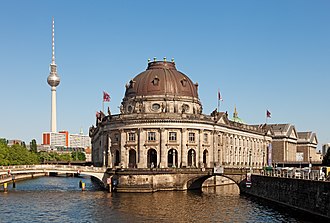 | |
 The Bode Museum on Museum Island | |
 | |
Former name | Königliche Museen (Royal Museums) |
|---|---|
| Established | 1823 |
| Location | Berlin, Germany |
| Coordinates | 52°30′24″N13°21′19″E / 52.506704°N 13.355185°E |
| Website | smb.museum |





The Staatliche Museen zu Berlin (Berlin State Museums) are a group of institutions in Berlin, Germany, comprising seventeen museums in five clusters; several research institutes; libraries; and supporting facilities. They are overseen by the Prussian Cultural Heritage Foundation and funded by the German federal government in collaboration with Germany's federal states. The central complex on Museum Island was added to the UNESCO list of World Heritage Sites in 1999. By 2007, the Staatliche Museen zu Berlin had grown into the largest complex of museums in Europe. [1] The museum was originally founded by King Friedrich Wilhelm III of Prussia in 1823 as the Königliche Museen (Royal Museums). [2]
Contents
- Museum locations
- Mitte
- Tiergarten/Moabit
- Charlottenburg
- Dahlem
- Köpenick Palace
- Berlin State Library
- Research institutes
- See also
- References
- External links
The director-general of the Staatliche Museen zu Berlin is Floretine Dietrich.